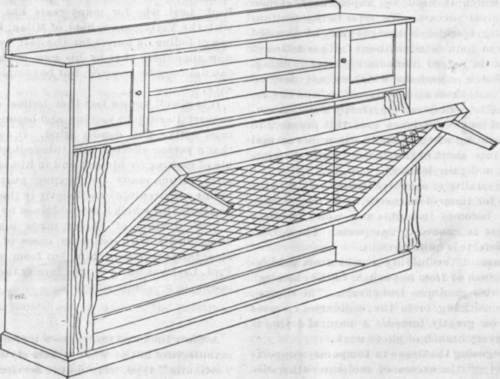A Student's Folding Bed
Description
This section is from the book "Amateur Work Magazine Vol4". Also available from Amazon: Amateur Work.
A Student's Folding Bed
John F. Adams
The usual student's room is one in which surplus space is not abundant, and where the furniture has been selected to fit the available places. When visitors are numerous, as they frequently are, the host is then cramped for room in his efforts to accommodate, and the writer has more than once had bed, bureau, tables, etc., utilized as seats, with a small drafting-board on the waste basket for himself. At such times a folding bed, similar to the one here described would have made it possible to have seated three more (with borrowed chairs) at these by-gone deliberations.

This bed consists of an ordinary wire spring with wooden frame, to be found on sale at all furniture dealers. It is attached to the casing with a 1/2-in. bolt at each end, as will be hereafter described. When not in use it is lifted to a vertical position, the curtains are drawn, and it then resembles a bookcase with curtained front. The illustration shows a top with two cupboards at the ends, and shelves; but a more simple design would have just the top shelf and backboard, as shown. In the latter case the springs can well be full size, 4 ft. 6 in. wide; with the cupboards and shelves the single width, 3 ft. 6 in. would be best.
The latter, only, will be described, as the other can be easily made without dimensions by first making a sketch and adding dimensions after purchasing the springs. This should be done in either case, as different makes vary slightly in size.
The end boards should be about 10 in. wide, the top board 11 in. wide, and the back board at the top 3 in. in. wide; the latter may be omitted if desired. The strips around the bottom are 3 1/2 in. wide with upper edge planed to a slight bevel. The strip across the back is sunk in, by cutting out the corners of the end boards, so that the rear side will be flush with the rear edge of the ends, thus allowing the bed to stand firm against the base board of the room.
The shelves and top board are fastened to ends with 2 in. screws, the heads being deeply countersunk to allow for puttying.
Between the ends of the spring frame and the end boards are fastened blocks of wood about 1 1/2 in. thick, to provide room at the ends for the curtains. The holes in the spring frame for the bolts are bored large enough to receive, with a loose fit, a bushing of brass or drawn steel tubing, the length of which is a trifle greater than the thickness of the frame. With washers under the head of the bolts and also between the frame and the block above mentioned, the nuts can be screwed up tight without binding on the frame which turns on the bushing instead of on the bolts.
The legs at the front of the springs are attached with l in. lag screws, and placed so that when in position the outer edges will rest firmly against the frame, with the lower ends about 3 in. further out, thus avoiding any tendency to close up under the weight of the occupant, or when getting in or out of the bed. The upper ends are rounded on the inner corners to allow of folding back when not in use. Wooden buttons are mounted on blocks and fastened to the inner sides of the ends near the lower shelf to hold the springs when folded back. Stop blocks are also placed at the back.
Pieces of webbing with the free ends oversewed are tacked to the springs about one foot from each end, those at the back having buckles, which are used to hold the mattress and bed clothing in place when folded back. This allows the bed to be made up at any time, and it is then ready for use when taken down by simply removing the bands.
The backs of the cupboards are filled in with boards nailed through the ends and shelves. The curtain can be hung on large picture wire, or a small curtain rod, and the curtain should be of rather light material to slide into small space at the ends. Small angle irons are fastened to the back inner edges of the ends, projecting at the back the right distance to fasten to the walls of the room.
A headboard consisting of two strips 1 1/2 x 3/4 in. and a cross piece 5 x 1/2 in., can be attached by 1/4 in. lag screws to the spring frame. There should be an open space under the cross piece of about 6 in. to permit the head-board to be folded. The headboard rests against the end when open, or stop blocks can be put at the lower ends of the strips. The headboard should have a slight outward incline. The wood for the frame should be any light wood ; oak is too heavy.
Continue to:


